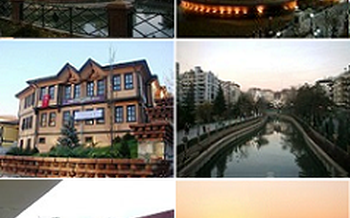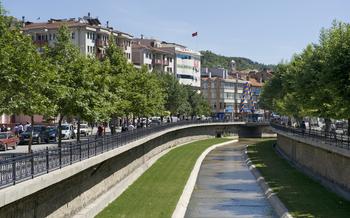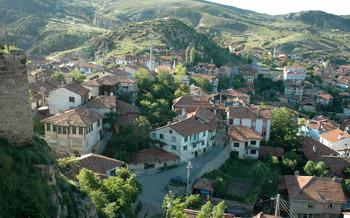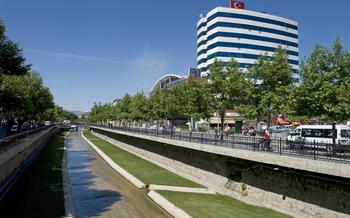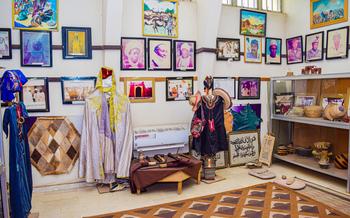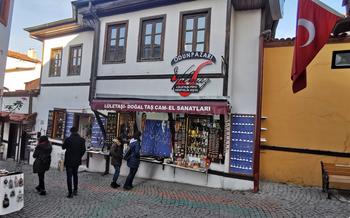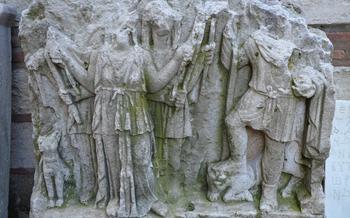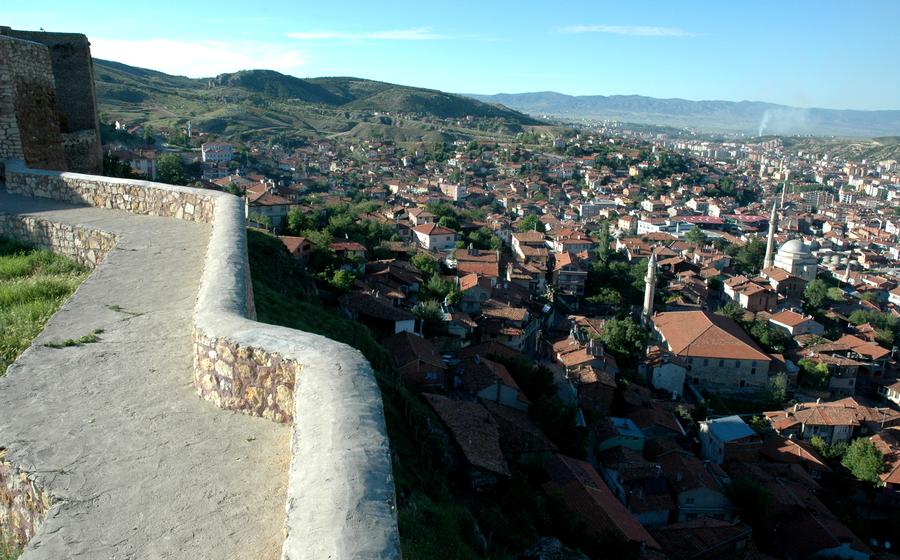
Kastamonu Entekke Bazaar
- Kastamonu Entekke Bazaar: A Historical and Cultural Gem
- Location and Accessibility
- Exploring the Bazaar's History
- Architectural Marvels
- Shopping Delights
- Culinary Adventure
- Textile Treasures
- Historical Mosques
- Craftsmanship and Artisans
- Cultural Performances
- Local Customs and Traditions
- Photography Opportunities
- Nearby Attractions
- Planning Your Visit
- Insider Tip: Uncovering Hidden Gems
Kastamonu Entekke Bazaar: A Historical and Cultural Gem
The Kastamonu Entekke Bazaar is a vibrant and bustling marketplace that has been the heart of the city for centuries. With its labyrinthine alleys, colorful shops, and friendly locals, the bazaar offers a unique and immersive experience for visitors from around the world.
Established in the 15th century during the Ottoman Empire, the bazaar has stood as a testament to Kastamonu's rich history and cultural heritage. The bazaar's architectural design is a blend of traditional Turkish and Ottoman styles, featuring intricate carvings, arched doorways, and domed roofs.
The bazaar is a haven for those seeking authentic local experiences. Visitors can wander through the narrow streets, encountering friendly vendors who eagerly display their wares. From traditional Turkish handicrafts to mouthwatering delicacies, the bazaar offers a treasure trove of unique finds.
Whether you're a history buff, a passionate shopper, or simply someone looking for a glimpse into Turkish culture, the Kastamonu Entekke Bazaar is a must-visit destination that promises an unforgettable journey through time and tradition.
Location and Accessibility
The Kastamonu Entekke Bazaar is strategically situated in the heart of Kastamonu, Turkey. Nestled amidst narrow cobblestone streets and historic buildings, the bazaar is easily accessible on foot or by public transportation. For those arriving by car, parking is available in designated areas nearby.
To reach the bazaar, visitors can take a leisurely stroll from the city center, enjoying the charming scenery along the way. Alternatively, several bus lines stop within walking distance of the bazaar, making it convenient for those using public transport. Once you arrive, the vibrant atmosphere and enticing aromas will guide you through the labyrinthine alleys, leading you to the heart of this bustling marketplace.
Exploring the Bazaar's History
The Kastamonu Entekke Bazaar has a rich and fascinating history, dating back to the Ottoman era. It was initially established as a small market square in the 16th century, serving as a trading hub for local merchants and artisans. Over time, the bazaar grew in size and significance, becoming one of the most important commercial centers in the region.
The bazaar's architecture reflects the cultural influences of various civilizations that have shaped Kastamonu's history. The traditional Ottoman-style buildings, with their intricate carvings and colorful facades, stand alongside structures showcasing European influences, a testament to the city's diverse heritage.
Throughout its existence, the bazaar has witnessed numerous events and milestones that have left their mark on its character. From bustling trade fairs to religious festivals, the bazaar has been a vibrant gathering place for locals and visitors alike. It has also played a pivotal role in Kastamonu's economic and social development, contributing to the city's prosperity and cultural identity.
Architectural Marvels
The Kastamonu Entekke Bazaar boasts a rich architectural heritage that has been carefully preserved over the centuries. Wander through its narrow cobblestone streets and discover historic buildings, mosques, and landmarks that showcase a blend of traditional Ottoman and Seljuk architecture. Admire the intricate carvings, domes, and minarets that adorn these structures, telling tales of a bygone era.
One of the highlights of the bazaar is the Entekke Mosque, a beautiful example of Ottoman architecture dating back to the 16th century. Its impressive dome and graceful minaret dominate the skyline, inviting visitors to step inside and marvel at its serene atmosphere and elegant interior. The mosque's intricate tilework and calligraphy inscriptions add to its charm, making it a must-see for architecture enthusiasts.
As you explore further, you'll encounter historic shops and workshops that have stood the test of time. Their wooden facades and colorful shutters add to the bazaar's vibrant character. Pay attention to the intricate details and decorative elements that adorn these buildings, such as carved lintels, arched doorways, and colorful window frames. They reflect the skill and artistry of Turkish craftsmen and serve as a reminder of the bazaar's rich history.
Shopping Delights
Kastamonu Entekke Bazaar is a shopper's paradise, offering a diverse array of local handicrafts, souvenirs, and unique products. From intricately handwoven carpets and kilims to exquisite pottery, jewelry, and metalwork, the bazaar is a treasure trove of traditional Turkish craftsmanship.
Strolling through the narrow cobblestone streets, visitors can browse through an array of shops and stalls, each showcasing the talents of local artisans. The air is filled with the sound of haggling and the smell of freshly baked goods, creating a vibrant and lively atmosphere.
For those seeking one-of-a-kind souvenirs, the bazaar is the ideal place to find unique pieces that reflect the rich cultural heritage of the region. Whether it's a hand-painted ceramic plate, a delicately embroidered textile, or a beautifully crafted piece of jewelry, there's something to suit every taste and budget.
To fully immerse in the shopping experience, it's essential to embrace the local tradition of bargaining. Don't be afraid to engage in friendly negotiations with the shopkeepers, as it's not only expected but also a way to show respect and build a connection.
However, it's important to remember that bargaining should be done with a smile and a respectful attitude. Be prepared to walk away if the price is too high, as there are plenty of other options within the bazaar.
Culinary Adventure
A visit to the Kastamonu Entekke Bazaar is not complete without savoring the delectable local cuisine. From traditional Turkish dishes to unique regional specialties, the bazaar offers a culinary adventure that will tantalize your taste buds.
- Must-Try Delicacies:
Indulge in the famous "Kastamonu köftesi", succulent meatballs served with a rich tomato sauce. Sample the "mantı", delicate dumplings filled with ground beef and yogurt sauce. Don't miss the "yaprak sarma", tender grape leaves stuffed with rice, herbs, and minced meat.
- Food Stalls and Restaurants:
Venture into the bazaar's narrow alleys to discover hidden food stalls serving up mouthwatering street food. Try the freshly baked "gözleme", a flatbread filled with cheese, spinach, or potatoes. Visit the traditional restaurants for a more leisurely dining experience, where you can savor grilled meats, stews, and hearty soups.
- Tips for Vegetarians and Dietary Restrictions:
Vegetarians will find plenty of options, such as stuffed vegetables, lentil dishes, and fresh salads. Be sure to communicate any dietary restrictions to the vendors or restaurant staff, as they are usually accommodating and can prepare dishes according to your needs.
Textile Treasures
Kastamonu is renowned for its exquisite textiles, a legacy that dates back centuries. Within the Entekke Bazaar, you'll find a vibrant cluster of shops and stalls dedicated to these handcrafted treasures.
Handwoven Carpets and Kilims:
Marvel at the intricate handwoven carpets and kilims that adorn the bazaar. Each piece is a unique work of art, showcasing traditional patterns, vibrant colors, and exceptional craftsmanship.
Traditional Techniques and Designs:
Witness the meticulous techniques employed by local weavers as they create these masterpieces. From the spinning of the yarn to the intricate knotting and weaving, each step is carried out with precision and care.
Storytelling Through Textiles:
These textiles are not just decorative pieces; they tell stories of the region's culture, history, and traditions. The patterns and motifs often draw inspiration from nature, local legends, and nomadic tribes.
Historical Mosques
Within or near the Kastamonu Entekke Bazaar, you'll find several significant mosques that are architectural marvels and religious landmarks. One of the most prominent is the Ulu Mosque, located in the heart of the bazaar. Built in the 14th century, it showcases Seljuk architectural elements with its intricate stone carvings and impressive dome.
Another must-visit is the Nasrullah Mosque, known for its unique hexagonal minaret. Explore its serene courtyard, adorned with beautiful tiles and calligraphy, which provides a tranquil escape from the bustling bazaar.
Before entering any mosque, remember to dress respectfully and follow local customs. Women should cover their heads with a scarf, and both men and women should remove their shoes before stepping inside. This demonstrates respect for the sanctity of these holy places and helps preserve the cultural heritage of the bazaar.
Craftsmanship and Artisans
Kastamonu Entekke Bazaar is a haven for artisans and traditional craftspeople who showcase their exceptional skills and artistry. Within the labyrinthine streets of the bazaar, you can find workshops where artisans meticulously create exquisite pottery, intricate metalwork, and finely carved woodwork.
Witnessing these artisans at work is a mesmerizing experience. The potter's wheel spins as they shape clay into elegant forms, the blacksmith's hammer strikes with precision, transforming metal into intricate designs, and the woodcarver's chisel dances across the wood, revealing hidden patterns and textures.
Engaging with these artisans offers a unique opportunity to learn about their techniques, the history behind their crafts, and the stories behind each piece they create. You can even purchase one-of-a-kind pieces directly from the artisans, ensuring that you take home a truly special souvenir from your visit to Kastamonu Entekke Bazaar.
Cultural Performances
Kastamonu Entekke Bazaar is not just a place for shopping and sightseeing; it is also a vibrant hub of cultural expression. Throughout the year, the bazaar comes alive with traditional Turkish music, dance, and performances that showcase the rich cultural heritage of the region.
One of the highlights of the bazaar's cultural scene is the traditional Turkish folk dance known as "halay." Performed by groups of men and women, the halay is a lively and energetic dance that involves intricate steps and rhythmic clapping. Visitors can often witness impromptu performances of the halay in the bazaar's courtyards, creating a festive and joyous atmosphere.
In addition to folk dances, the bazaar also hosts regular concerts and musical performances featuring local musicians and artists. These performances often take place in the bazaar's historic courtyard, providing a unique and intimate setting for visitors to enjoy traditional Turkish music.
For those interested in experiencing the full spectrum of Turkish culture, the Kastamonu Entekke Bazaar offers a variety of cultural events and performances that provide a glimpse into the region's rich heritage and traditions. Whether it's the lively halay, soulful music, or captivating storytelling, there is something for everyone to enjoy in this vibrant and dynamic marketplace.
Local Customs and Traditions
When exploring the Kastamonu Entekke Bazaar, it's essential to immerse yourself in the local customs and traditions that shape its vibrant atmosphere. The people of Kastamonu are renowned for their warm hospitality and welcoming nature, eager to share their culture with visitors.
As you stroll through the bazaar, you'll encounter friendly shopkeepers who may offer you a cup of tea or engage in friendly conversation. Embrace these interactions as an opportunity to learn about their lives, experiences, and perspectives. Respectful curiosity and a genuine interest in their stories will be greatly appreciated.
Remember to observe local customs and etiquette when visiting the bazaar. Dress modestly, covering your shoulders and knees, especially when visiting mosques or religious sites. Be mindful of local customs regarding personal space and avoid standing too close to others.
When bargaining for goods, approach the process with patience and respect. Negotiations are a part of the shopping experience, and a friendly demeanor can often lead to better deals. However, always be prepared to walk away if the price doesn't suit you.
By respecting local customs and traditions, you'll not only enhance your experience at the Kastamonu Entekke Bazaar but also foster meaningful connections with the local community, creating a truly memorable and respectful travel experience.
Photography Opportunities
The Kastamonu Entekke Bazaar is a visual feast for photographers, offering countless opportunities to capture the essence and beauty of this historic marketplace.
Picturesque Corners: The bazaar is a maze of narrow cobblestone streets, colorful storefronts, and hidden courtyards. Take your time to explore and discover picturesque corners that tell stories of history and tradition.
People and Portraits: The bazaar is a vibrant hub of activity, filled with locals going about their daily lives. Capture candid portraits of shopkeepers, artisans, and customers, each with their unique stories to tell.
Architectural Details: The bazaar is adorned with intricate architectural details, from ornate doorways and window frames to decorative tiles and carvings. Zoom in to capture the craftsmanship and beauty of these elements.
Textures and Patterns: The bazaar is a treasure trove of textures and patterns, from the woven textiles and carpets to the colorful pottery and metalwork. Play with light and shadow to create striking compositions.
Moments of Connection: Look for moments of connection between people—a shopkeeper sharing a laugh with a customer, artisans working together, or friends enjoying a cup of tea. These candid moments capture the essence of the bazaar's community spirit.
Ethical Considerations: Always ask permission before photographing people, especially women and children. Respect their privacy and be mindful of cultural sensitivities when taking photos in religious spaces.
Nearby Attractions
Kastamonu is home to a wealth of historical, natural, and cultural attractions beyond the Entekke Bazaar. Embark on a journey to Tokatlı Canyon, a breathtaking natural wonder with stunning rock formations and hiking trails. Delve into the history of the city at the Kastamonu Museum, showcasing artifacts from different eras. For a serene escape, visit the Seyyid Harun Veli Tomb, a tranquil oasis with lush gardens and a spiritual atmosphere.
Venture further to explore the surrounding region. Discover the ancient ruins of Pompeiopolis, a once-thriving Roman city with well-preserved mosaics and structures. Immerse yourself in the natural beauty of Ilgaz Mountain National Park, offering breathtaking landscapes, hiking trails, and opportunities for wildlife spotting. Plan a day trip to Safranbolu, a UNESCO World Heritage Site renowned for its well-preserved Ottoman architecture and vibrant cultural heritage.
Create a comprehensive itinerary that allows you to delve into the diverse attractions of Kastamonu and its surroundings. Dedicate a day to explore the Entekke Bazaar, another day for visiting nearby historical sites, and set aside time to immerse yourself in the region's natural wonders. With its rich tapestry of history, culture, and natural beauty, Kastamonu offers an unforgettable travel experience that will leave you captivated.
Planning Your Visit
To fully immerse yourself in the vibrant atmosphere of the Kastamonu Entekke Bazaar, plan your visit during the spring or autumn months when the weather is pleasant and the crowds are smaller. Dedicate at least half a day to explore the bazaar's labyrinthine streets, allowing ample time to browse the shops, savor the local delicacies, and engage with the friendly locals. For a more serene experience, avoid visiting during peak tourist season or on weekends when the bazaar buzzes with activity. Embrace the opportunity to wander aimlessly, letting the sights, sounds, and aromas guide your exploration. This spontaneous approach often leads to unexpected discoveries and memorable encounters.
Insider Tip: Uncovering Hidden Gems
Beyond the main thoroughfares of the Kastamonu Entekke Bazaar, there are hidden gems that offer unique experiences to discerning travelers. One such gem is the "Lost Courtyard," a secluded courtyard tucked away between two rows of shops. Here, visitors can find a tranquil oasis amidst the bustling bazaar, with a traditional Turkish tea garden serving aromatic brews and delectable sweets.
For those seeking authentic handicrafts, the "Artisan's Workshop" is a must-visit. Located in a quaint corner of the bazaar, this workshop showcases the skills of local artisans who create exquisite pottery, intricate metalwork, and hand-carved wooden artifacts. Visitors can watch the artisans at work and purchase one-of-a-kind pieces directly from the source.
If you're a fan of photography, don't miss the "Secret Viewpoint," a hidden terrace overlooking the rooftops of the bazaar. This spot offers a panoramic vista of the bustling marketplace, with the majestic Kastamonu Castle in the backdrop. It's the perfect place to capture stunning photos and soak in the vibrant atmosphere of the bazaar.
To truly immerse yourself in the local culture, attend one of the traditional Turkish music and dance performances held in the bazaar's central courtyard. These performances, often featuring whirling dervishes, belly dancers, and folk musicians, offer a glimpse into the rich cultural heritage of Kastamonu. Check with the local tourism office for performance schedules and venues.
